There was a six-year span in my life when much of what seemed significant happened inside or within a few blocks of the Princess Theatre. On Whyte Avenue in Old Strathcona, the Princess seemed to anchor the old neighbourhood near the university
in Edmonton, Alberta, Canada. I lived with my friends. I learned to cherish music, I laughed my head off, wailed in pain, drank beers, trusted dreams, tripped over innocence and disappointment, and almost died.
It was in the Princess that the clutch of books then taking over my brain were joined by films.
Mostly foreign films, through which the call of a wider world grew more insistent, a wider world that came with subtitles.
A world in eclectic, random stream. In the form of Jean de Florette (1986) and Au Hasard Balthazar (1966). Of Metropolis (1927) and Murder on the Orient Express (1934). Through The Seventh Seal (1957), but also Jules et Jim (1961) and Last Tango in Paris (1972). The world via Citizen Kane (1941) and The Third Man (1949), seeing Bob Marley Live at the Rainbow (1977) and the oddly captivating Peter Sellers in Dr Strangelove (1964), the Pink Panther series (1963-1978) and The Party (1968).
And it was from my favoured vantage in the balcony at the Princess that I first saw Werner Herzog’s 1972 film Aguirre: The Wrath of God.
Two things stood out to me at first viewing.
First, the opening scene, as a preposterously-encumbered Spanish exploration party descends from the mountains into the tropical jungle in the uppermost reaches of the Río Marañon, as the Amazon was called at the time.
And, second, the unforgettable face of Klaus Kinski, the actor who plays Lope de Aguirre.
It was a face that immediately took me back to another film seen at the Princess. Kinski’s cameo in Dr Zhivago [1965], in which he played an anarchist prisoner on a train headed for the gulag. I say "face," but Kinski conjures Aguirre with his entire body. With his way of carrying himself, the drag and a “lean."1
I absorbed that opening scene and that face, that disturbing, insistent body. But I’m not sure how much else.
What I certainly didn’t think much about was just how Werner Herzog’s film was treating “history," how he was working out what Inga Clendinnen has called “the mysteries and ambiguities of actual experience.” I wasn't wondering about how the film-maker Herzog’s selectivity and curiosities might relate to those of a historian charged with “disciplined, critical remembering” before a historical record, nor was I considering the after-effects, for me and other viewers.2
In Aguirre: The Wrath of God, Herzog merges, borrows, and deliberately departs from the earliest accounts of a series of sixteenth-century Spanish expeditions in search of the land of El Dorado, “the Gilded one.” El Dorado was a shifting, shimmering dream, a legendary Indigenous kingdom of untold riches that figures such as Herzog’s composite-conquistador invention, “Aguirre,” thought lay somewhere in the South American interior.
The film-maker weaves in and out of surviving evidence, concentrating upon part of what befell an ill-fated splinter expedition into Amazonia led by a Navarrese would-be conqueror named Pedro de Ursúa. May the briefest of recaps whet appetites rather than spoil the film for those who have not seen it.
It is late September, 1560. On a great number of hastily constructed rafts and brigantines, Ursúa takes to the river with some 300 soldiers, scores of enslaved African captives and Indigenous bearers and guides, horses, munitions, and supplies. His expedition in search of El Dorado includes a young nobleman from Seville, Fernando de Guzmán.
And there is also a certain soldier, long in the service of his king, a fifty-year old native of the Basque country named Lope de Aguirre, played by Kinski. Aguirre has been wounded, in more ways than one, in the protracted civil wars that had afflicted vast Peru in the wake of Pizarro’s treacherous capture and execution of the Inka Atahuallpa.
Several women accompany the enterprise, including Ursúa’s Creole mistress and Aguirre’s Mestizo daughter.
As the river sweeps the heavily laden vessels eastward into rapids the rafts and brigantines begin to collapse, a group is separated, and things go to hell. The band resorts to violence, raiding and pillaging riverside communities. Horses and supplies disappear about as quickly as the Indigenous oarsmen, bearers, and guides.
Word spreads down river about just who is headed their way.
Fear mounts, hunger bites, matters grow desperate. Ursúa’s leadership is questioned, and he is soon killed by a band of conspirators, one of whom, Lope de Aguirre, emerges as the most eager.
Kinski’s Aguirre hisses as much as speaks. Proposing that the survivors now swear allegiance to the young and unlikely Fernando as king, Aguirre declares himself “the wrath of God, Prince of Liberty, and the kingdom of Tierra Firme and provinces of Chile.”
The film’s king Fernando is killed. The survivors build new brigantines for the river, and agree to follow Aguirre to El Dorado and beyond, in what becomes an open rebellion against the Spanish Crown’s right to rule over Spanish South America.
Werner Herzog digs in precisely here.
The film-maker is interested in a melodramatic story built around the principal mutineer, the band of “explorers” gone bad. Around the dashing of their dreams, and their fateful decision to forge on no matter what.
The film revels, memorably, in the potentialities offered by Aguirre’s lonely defiance and delusion upon the river.
But Herzog’s tack also leaves much untold. It wasn’t for nothing that Donald Stevens described the story of the historical Lope de Aguirre as “more compelling than fiction.”3
Lope de Aguirre and what was left of his band of Marañones negotiated that river, and ended up going back up the coast, eventually raiding towns on the island of Margarita and mainland of what is today Venezuela. From here, Aguirre not only entered into a wild set of negotiations with local officials, but also dictated a letter to the king, before launching an unlikely overland assault on “Peru.”
With a growing number of his remaining followers deserting him, Aguirre was finally surrounded near the town of Barquisimento by forces loyal to the king. On 27 October, 1561, after he had executed his own daughter rather than see her taken by his enemies, Aguirre was brought down, then drawn and quartered.
The extent to which the Crown wished to extinguish Aguirre’s example is captured by the words of his death sentence. In addition to his execution and the seizure of all his possessions, the judge recorded,
“I command that any houses that Aguirre might have left, wherever they might be, be levelled to the ground so that no trace or memory of them remains, and, once levelled, they shall be ploughed and sown with salt . . . . And I further declare that all of Aguirre's male offspring, whether legitimate or bastards ... shall become infamous as befits the children of a traitor and a tyrant, and I declare them unworthy of the honors of chivalry and of the dignity of any public office . . .”4
Aguirre, The Wrath of God “is not really a narrative of actual happenings or a portrait of actual people,” Werner Herzog later explained, “. . . it is a film about what lies behind landscapes, faces, situations, and works.”5 In other words, one is not investigating history, but rather being treated to a twentieth-century film-maker’s imagination of the physical and psychological predicaments that befall and are created by that face, in that environment.
Even so, looking back on a movie made more than a half-century ago —a film which itself distills and dramatises events from almost five centuries ago— poses challenges worth pondering.
It becomes all too easy for an audience in 2022 to wince at crude portrayals and blindspots, both those of the sixteenth century and those of the early 1970s.
One can regret, for instance, Herzog’s failure to represent Indigenous complexity and ingenuity in the riverine environments that made Europeans so uncomfortable, and his minimisation of enslaved Africans’ roles in the exploration parties. And it is likewise hard in the current moment not to lament an absence of what Aguirre’s and several other surviving accounts had to say about the astonishing flora and fauna of the region, about that river and that Amazonian environment as more than threat and menace.
Or, to take up Herzog’s treatment of European expeditioneers who do take centre stage: what about the film-maker’s decision to emphasise self-delusion and a degeneration into villainous treason and tyranny, paranoia and madness?
At hinted above, this narrative line avoids several possibilities, not least the challenge of portraying Lope de Aguirre as someone who made a chillingly perfect sense.
There is surviving evidence of Aguirre’s state of mind, his ways of thinking, and his manner of explaining things.
While many of Aguirre's words and actions were reported by others, amidst ten participants' accounts of the expedition, there is also a letter Aguirre dictated to a priest being held by the rebels, and addressed to King Philip II of Spain. And there are two other missives, as well, one Aguirre penned to a local governor and another to a Dominican provincial named Montesinos, then serving as a captain-general of the region where the Marañones came ashore. These letters, together with the other participant-accounts, illuminate not only what happened during those ten-months on the river, but also how deep-seated Lope de Aguirre's sense of grievance was as his entire world was falling apart.6
His “progressive disillusionment” —creating a mounting resentment and pent-up anger— recalled the perspectives of not a few transoceanic soldiers-for-hire in what has been called the late conquistador-adventurer generation.7 Here was another Spaniard with a long record of loyal service, one who had shown courage and undertaken notable risks and actions, and who, upon finding no El Dorado, felt bitter and passed over.
“It is my wish to see you all very prosperous, with Peru in your hand to divide as you desire,” Aguirre is reported to have said. “Leave things to me and Peru will be ruled and governed by Marañones, and there will be not a one among you who is not a captain in Peru ruling over other men . . . all I ask is that no one conceal anything or spread secrets, so that we may live safely and free from insurrection. And if you will be my friends, I will see to it that new Goths like those who ruled Spain arise from the Marañon to govern Peru.”8
The restorer of a medievalising Spanish Christian mythohistory; the insurrectionist promising a post-conquest harmony of friends across the seas, in lands free from secrets and insurrection . . .
And yet it's not hyperbole or anachronism or madness that still often sweeps Lope de Aguirre from the centre of a chronicling canon to its edges. It's the extent to which he took his defiance that differentiates him from his celebrated —and notably more measured— predecessor Bernal Díaz del Castillo, the soldier-chronicler of the conquest of Mexico who (after imbibing one too many accounts of the rebel-turned-providential-conqueror Hernán Cortés) finally wrote “to set the record straight.”9
When the compensations of booty and tribute, conquered lands and the right to exploit indigenous labour were not forthcoming – and at a time when waves of royal officials and bureaucrats, and members of the clergy, were arriving from Europe and would have seemed to be enriching themselves – the forgotten, passed-over ones seethed. In Lope de Aguirre’s case, the resentment came to feel like a betrayal worth dying for.
“We do not have to agree with what Aguirre did nor approve of his worldview," writes Thomas Holloway, "to conclude that his letter [and much else] is not the raving of a madman."10
Which brings us back to Herzog’s film.
How to think of films such as Aguirre, the Wrath of God? Films that engage with history? Films (and novels and television series) that play with how “the past” —and certain places too— will be known in a series of “presents” and for the future?
When a film-maker purports to address a definable historical person, place, event, or set of thoughts, is that film-maker (or writer or artist more generally) under any obligation to seek truthful representation?
In the case of Herzog’s film, which scenario satisfies today’s viewer more: being coaxed by superb cinematography, and by the rhetorical, visual, and emotional seduction of Aguirre’s descent into desolation and irrationality?; or being persuaded —through attention to broader contexts— that Lope de Aguirre makes rather perfect sense?
Would anyone be interested in a film about a bitter, disappointed, ultimately futile, and utterly representative late-generation conquistador Aguirre? Might there be more appetite for such a film in 2022 than there might have been fifty years ago?
If one is inclined to answer, as I am, that a film-maker ought to be left free to choose and to borrow and to invent —an artist whose craft and purpose in the world are different from those of a historical interpreter— what are the consequences?
Does it matter that a broadest audience —the so-called “public”—might well drink up the movie —and not just the movie, but the movie’s quickest stereotypes, its fastest, shoutiest, sexiest, most violent bits— as “fact,” as “history”?
Or, to sharpen the point, does it matter that, because of the reach and power of film and fiction, for many people Herzog’s Aguirre: The Wrath of God —even the face of Kinski and that vision of river and jungle— may well “become” early modern Spain, Spanish overseas conquests, conquistadores and conquests, and even colonialism’s consequences? And, further, that the film may come to “stand in” for much of South America, its peoples and cultures, and its environments?
* watercolours by Kenneth Mills
* This dispatch is lightly adapted from my “live” introduction to a screening of Aguirre, The Wrath of God at the State Theater in Ann Arbor, Michigan, USA, on Tuesday, 11 October 2022, part of the Department of History Film Series at the University of Michigan. Warm thanks to my colleague Elizabeth Collins and to Ellen Putney Moore of the Michigan Theater Foundation for the opportunity to launch the series.
* I am indebted to the “case for history” made by Inga Clendinnen (see n. 1), to Thomas Holloway’s essay on Aguirre (see n. 2), and to the still-ringing investigations of disillusionment and narrativised failure within Irving A. Leonard’s Books of the Brave (see n. 7) and in Beatriz Pastor Bodmer’s differently seminal The Armature of Conquest: Spanish Accounts of the Discovery of America, 1492-1589, trans. Lydia Longstreth Hunt (Stanford: Stanford University Press, 1992), originally El discurso narrativo de la conquista (1983). Also of note along these lines of inquiry, Joan-Pau Rubiés, “Futility in the New World: Narratives of Travel in Sixteenth-Century America,” in Voyages and Visions: Towards a Cultural History of Travel, eds. Jaś Elsner and Joan-Pau Rubiés (London: Reaktion Books, 1999), 74-100.
Thanks to Heidi Victoria Scott for pointing out that it’s not just his (Kinski’s Aguirre’s) face, “it’s his ‘lean.’”
Inga Clendinnen, “Representing the Holocaust: The Case for History,” Michigan Quarterly Review 36: 1 (1998), 92, 99; 80-99.
Donald F. Stevens, “Never Read History Again? The Possibilities and Perils of Cinema as Historical Depiction,” in Based on a True Story: Latin American History at the Movies, ed. Donald F. Stevens (Lanham, MD: Rowman & Littlefield, [1997] 2005), 7.
The entire sentence of Aguirre is included in the documentary appendix of Emiliano Jos, La expedición de Ursúa al Dorado y la rebelión de Lope de Aguirre y el itinerario de los“Marañones,” según los documentos de Archivo de Indias y varios manuscritos inéditos (Huesca, Spain: Imprenta V. Campo, 1927). I cannot improve on Beatriz Pastor’s translated passage in “Lope de Aguirre The Wanderer: Knowledge and Madness,” Dispositio 11: 28/29 (1986), 91; 85-98.
For this quotation from Herzog, see Thomas Holloway’s insightful “Whose Conquest is This Anyway? Aguirre, The Wrath of God,” in Based on a True Story, ed. Donald F Stevens ([1997] 2005), 15 and 150, n. 1; 29-46, originally quoted in S. S. Prawer, Caligari’s Children: The Film as Tale of Terror (New York: Oxford University Press, 1980), 19.
The letters are included in the documentary appendix to Emiliano Jos, La expedición de Ursúa al Dorado y la rebelión de Lope de Aguirre y el itinerario de los“Marañones” (1927). For another compilation of key texts, maps and supporting documents, see Elena Mampel González and Neus Escandell Tur, Lope de Aguirre: Crónicas, 1559–1561 (Barcelona: Editorial 7 1/2 Universidad de Barcelona, 1981). For Thomas Holloway’s translation into English of Aguirre’s letter to King Philip II in September of 1561, see Holloway, “Whose Conquest,” 30-33 respectively, and 151, nn. 7 and 9.
The phrase is Irving A. Leonard’s, from 1949, in his Books of the Brave: Being an Account of Books and of Men in the Spanish Conquest and Settlement of the Sixteenth-Century New World (Berkeley: University of California Press, [1949] 1992), 73.
Gonzalo de Zúñiga, “Relación de la jornada del Marañón,” in Colección de documentos del Archivo de Indias, ser. I, vol. 4, 246, quoted in Pastor, The Armature, 183.
Bernal Díaz del Castillo (1492-ca. 1580) completed his “true history of the conquest of New Spain” at the age of seventy-six. Better editions of this vivid text exist for scholarly purposes, both in the original Spanish and in English translation, but I remain partial to my dog-eared version of Bernal Díaz’s “historia verdadera” that I read around the time I was seeing films at the Princess Theatre, and being introduced to colonial Latin American history by Dr. David C. Johnson. See Bernal Díaz del Castillo, The Conquest of New Spain, translated by J. M. Cohen (London: Penguin Books, 1963). Cohen worked from the Historia verdadera de la conquista de nueva España, ed. Joaquín Ramírez Cabañas (Mexico City: Editorial Porrúa, fifth edition: 1960).
Holloway, “Whose Conquest?,” 30.


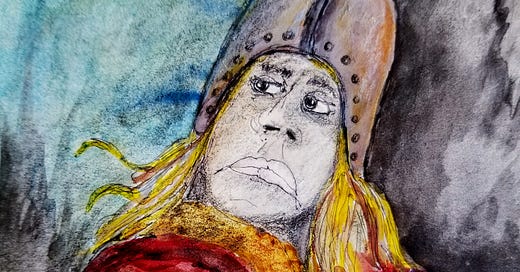



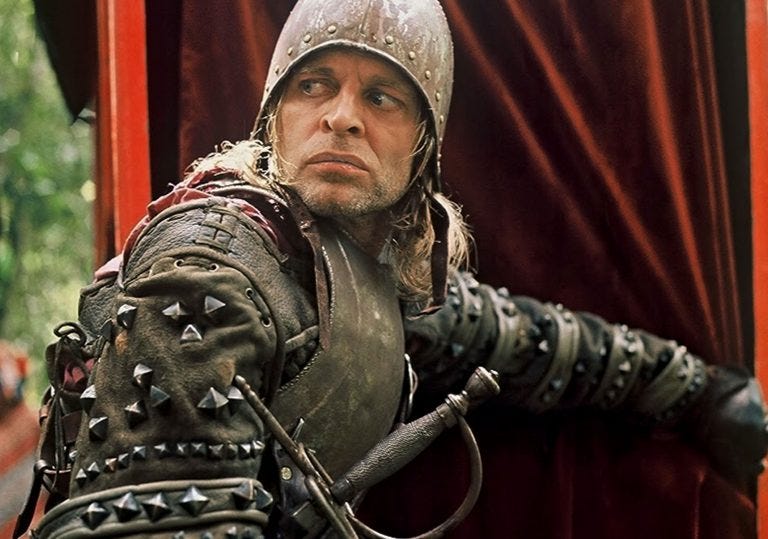
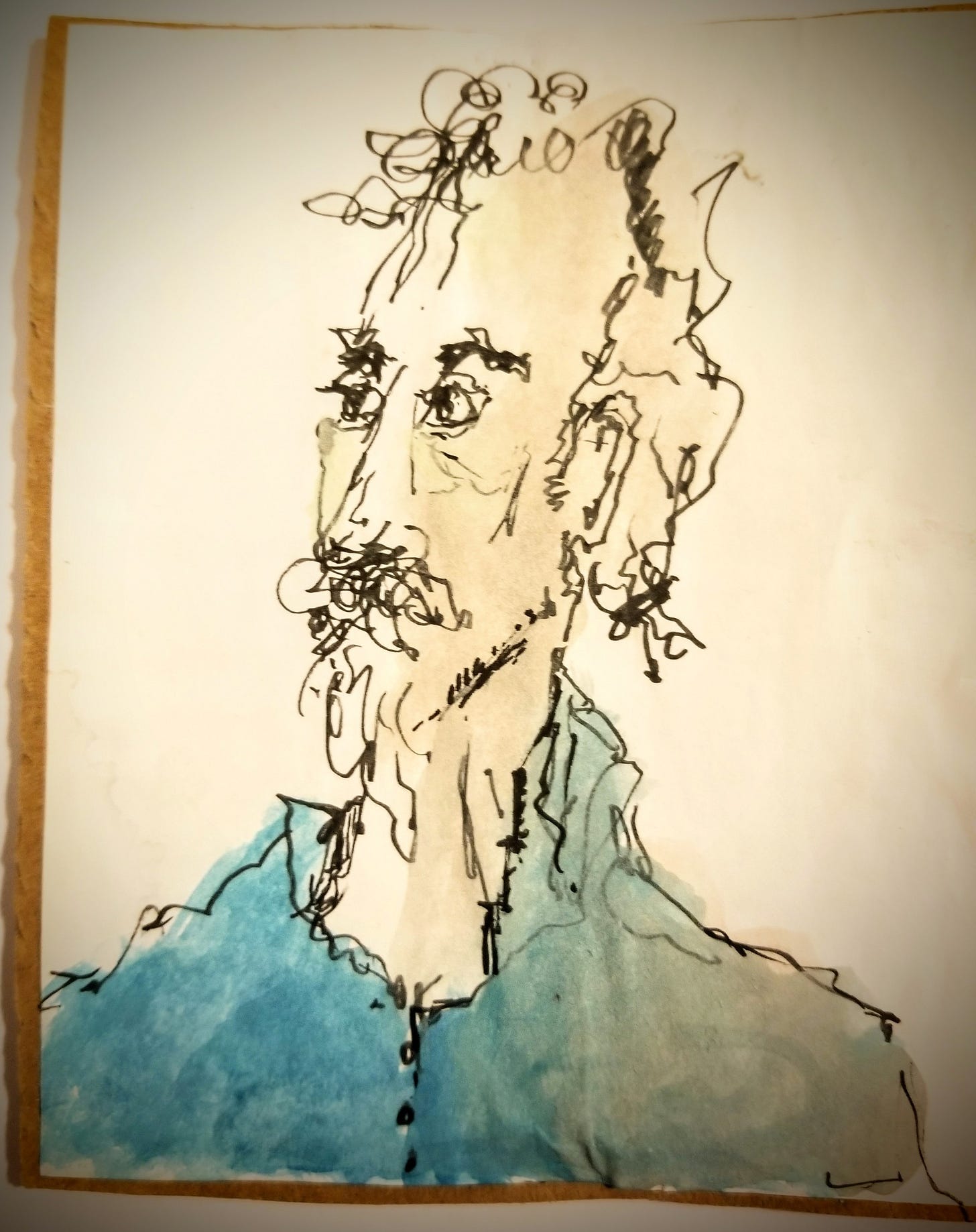
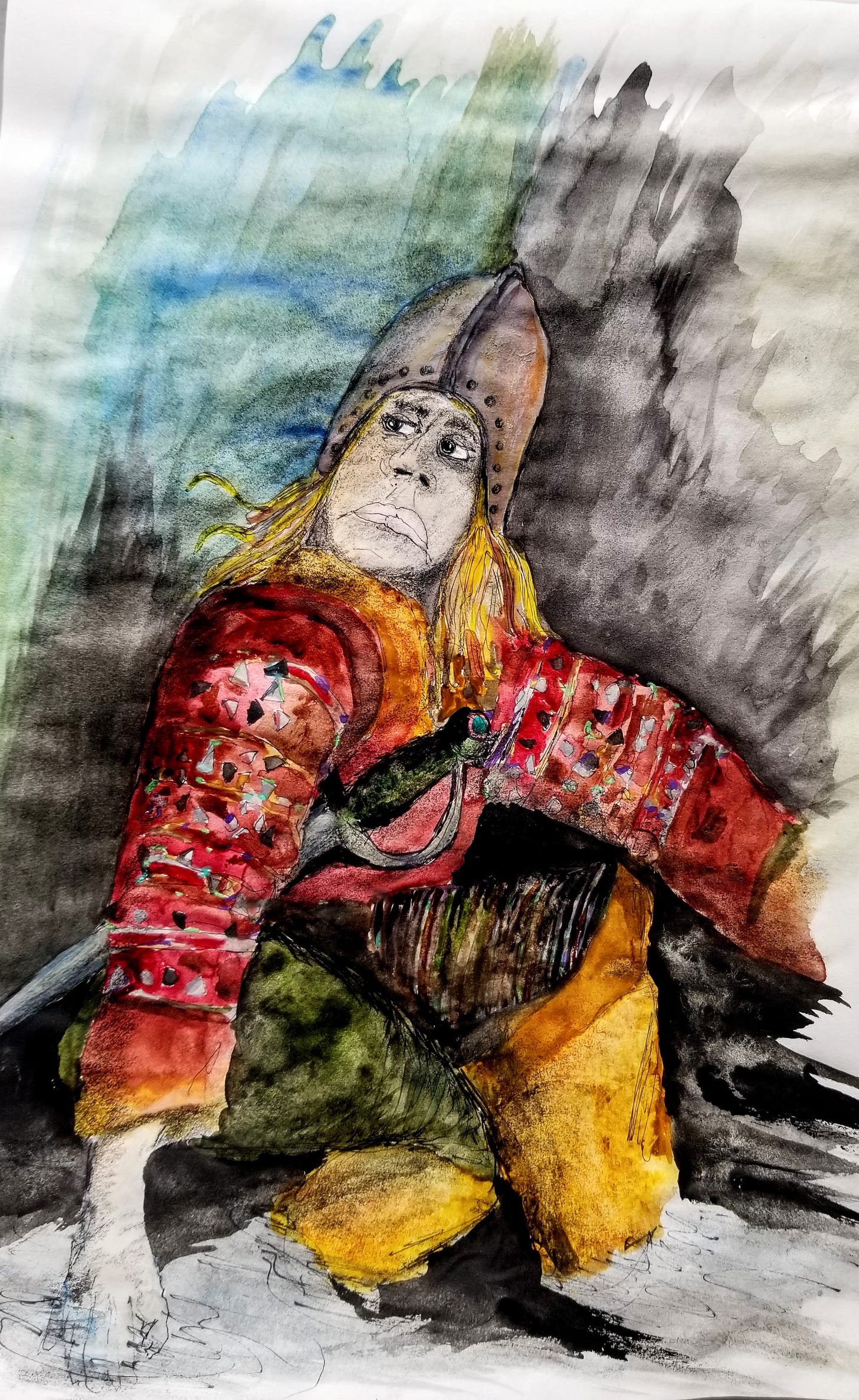
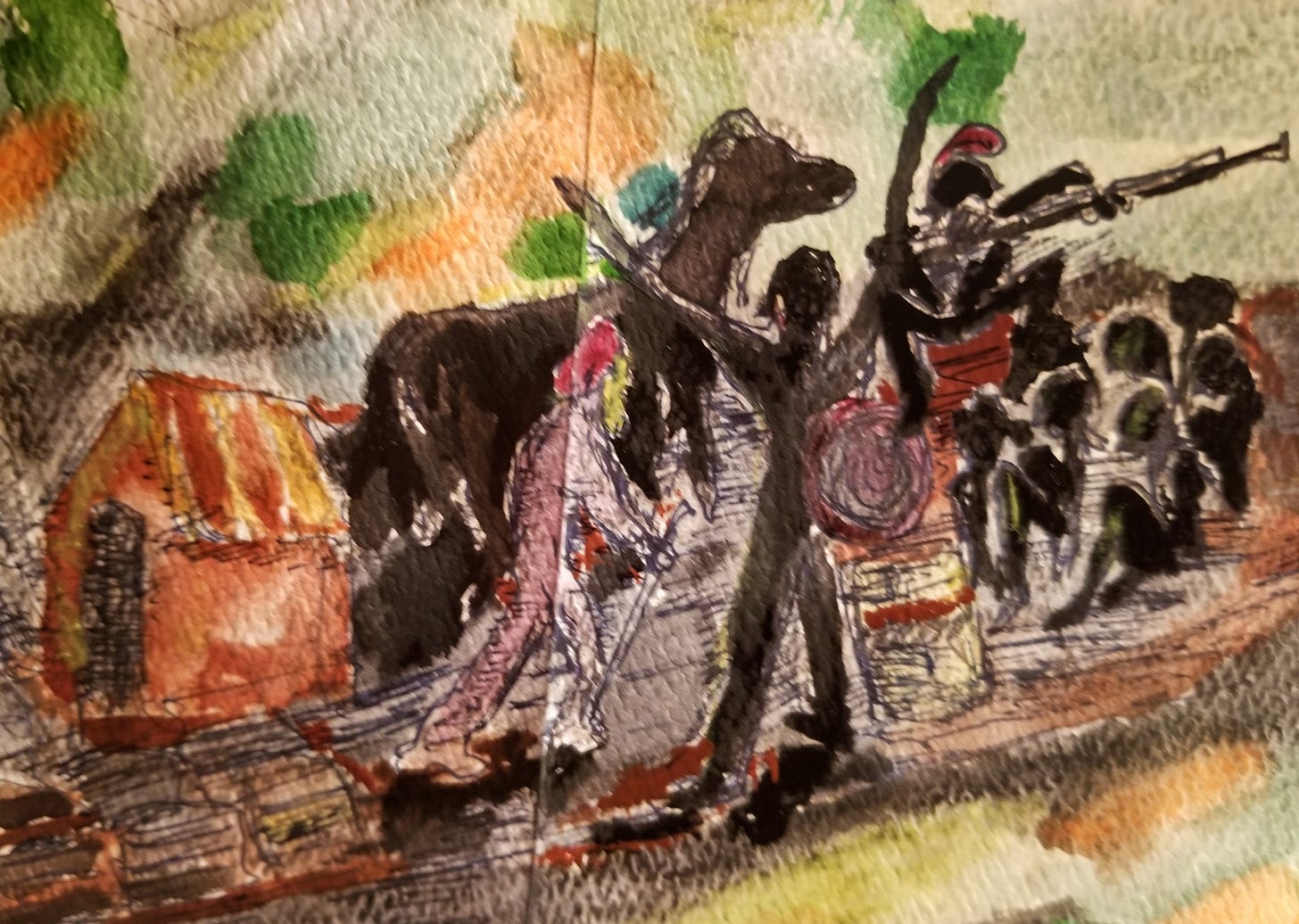
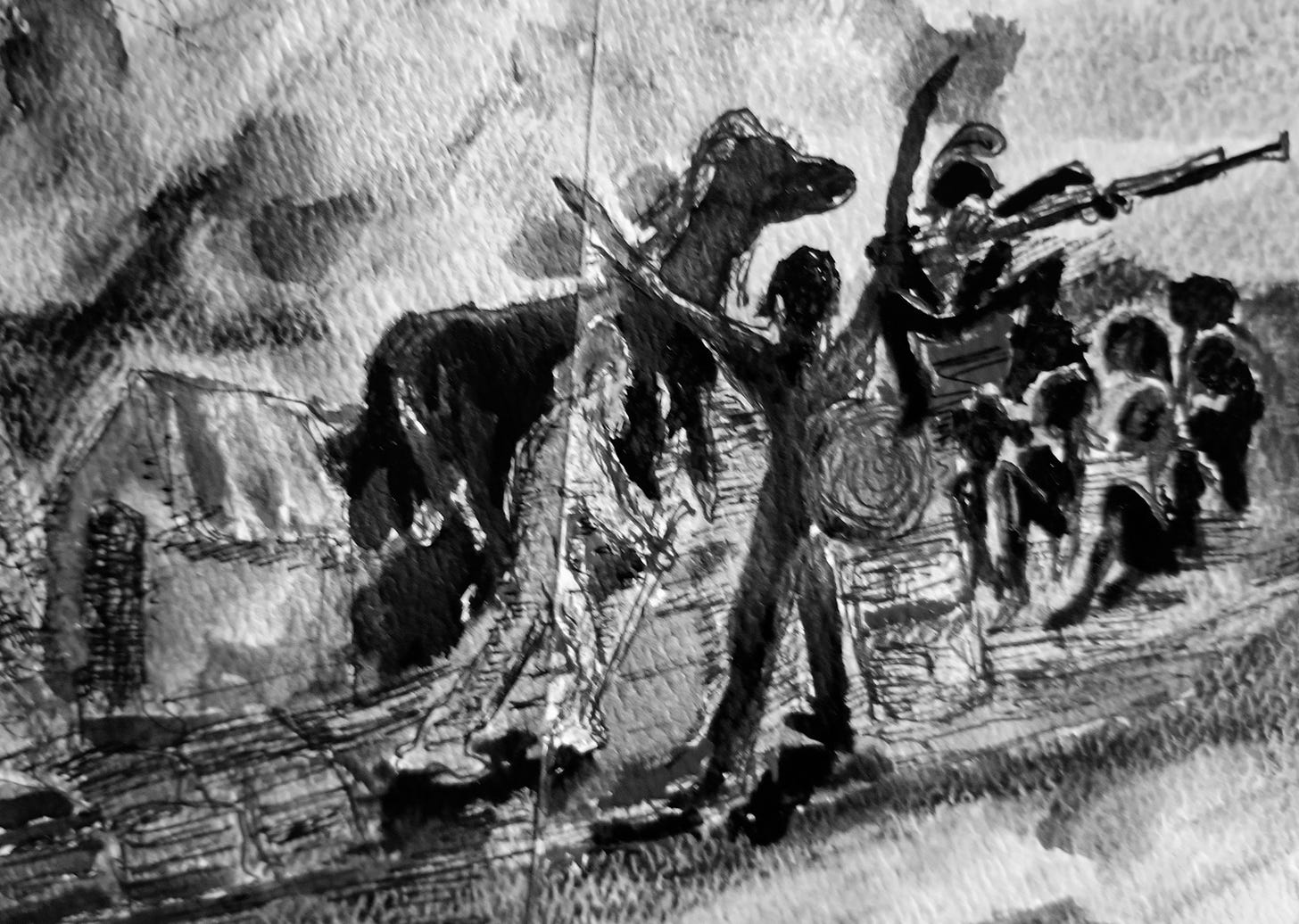
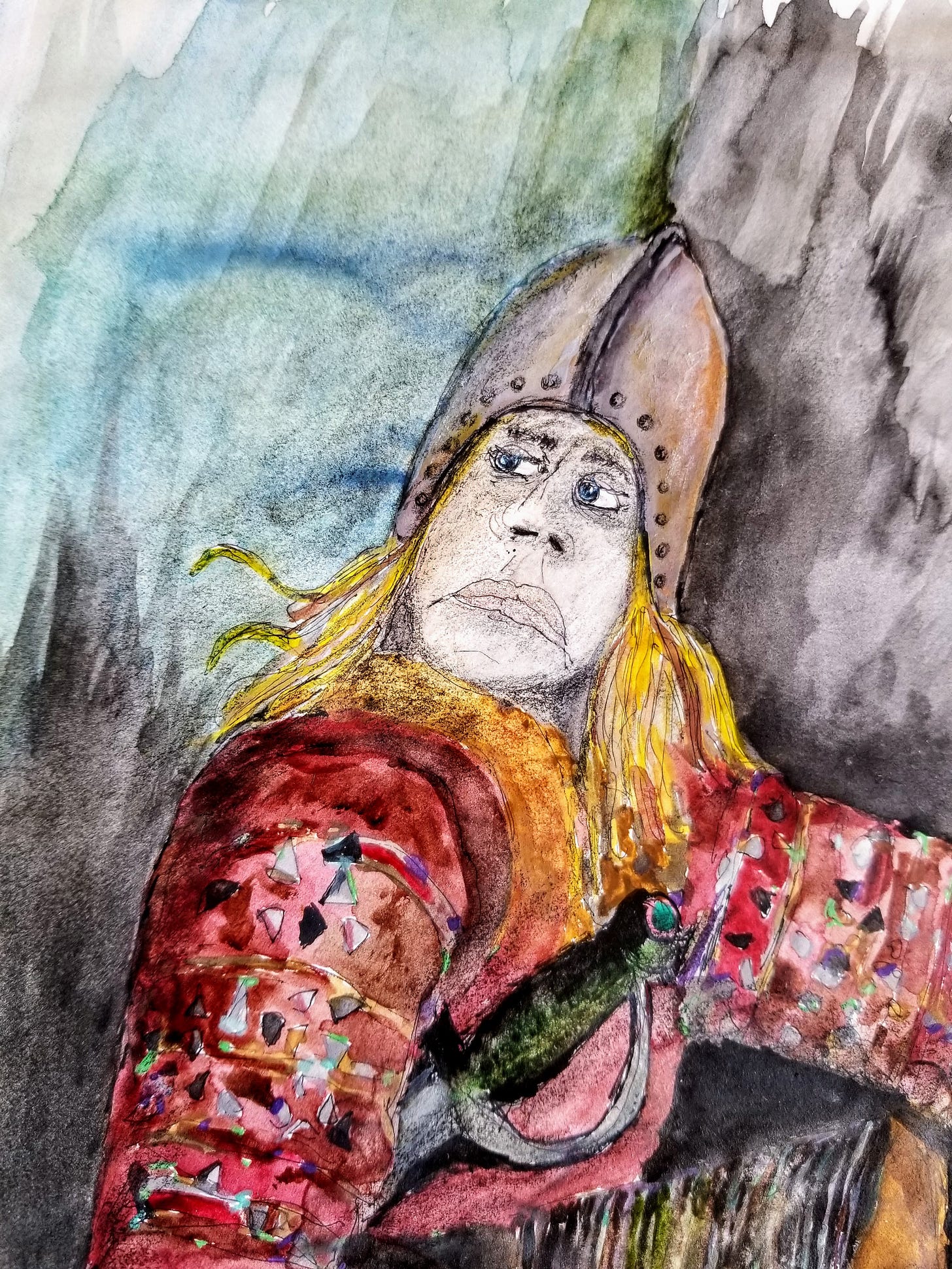
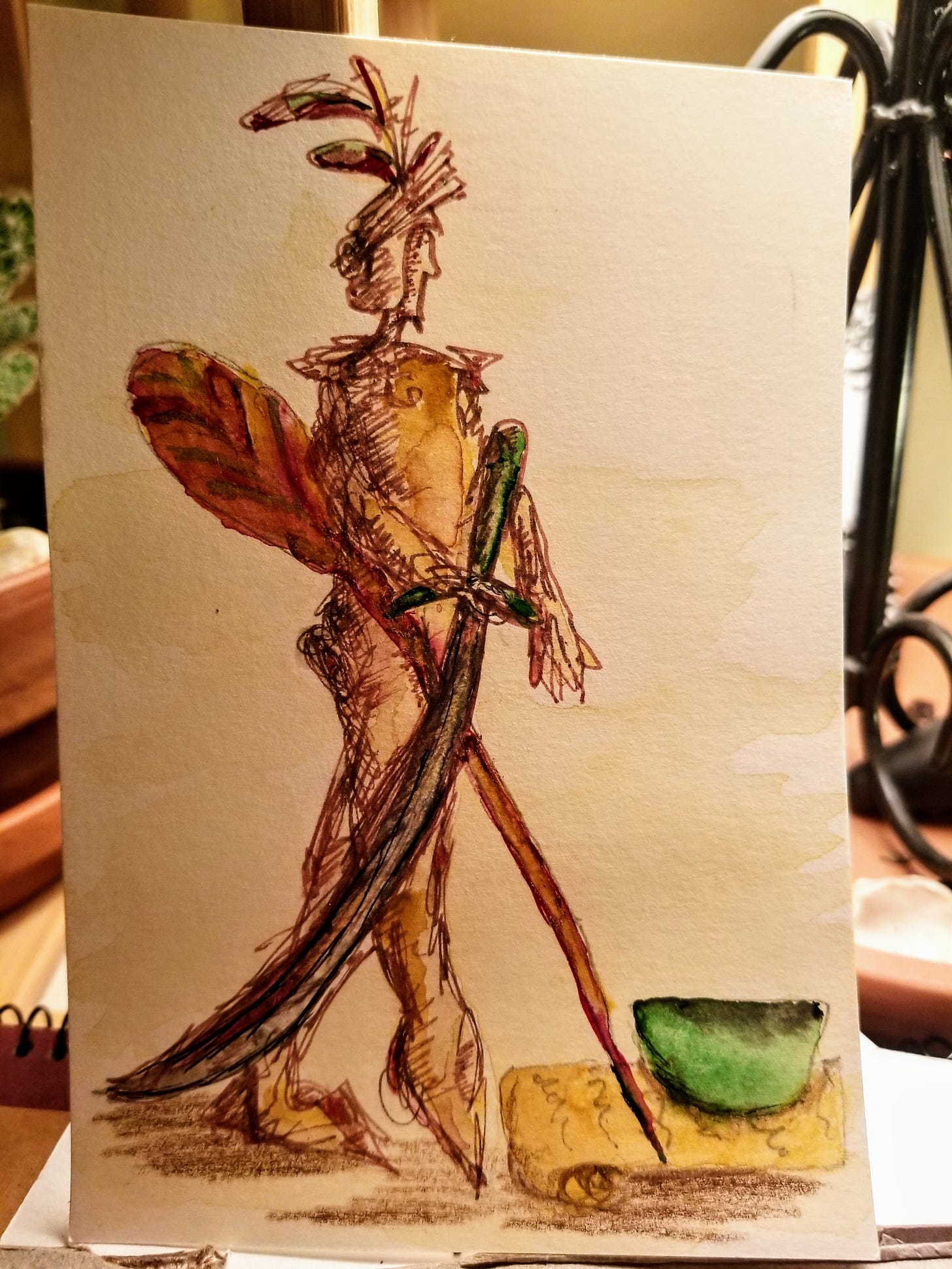
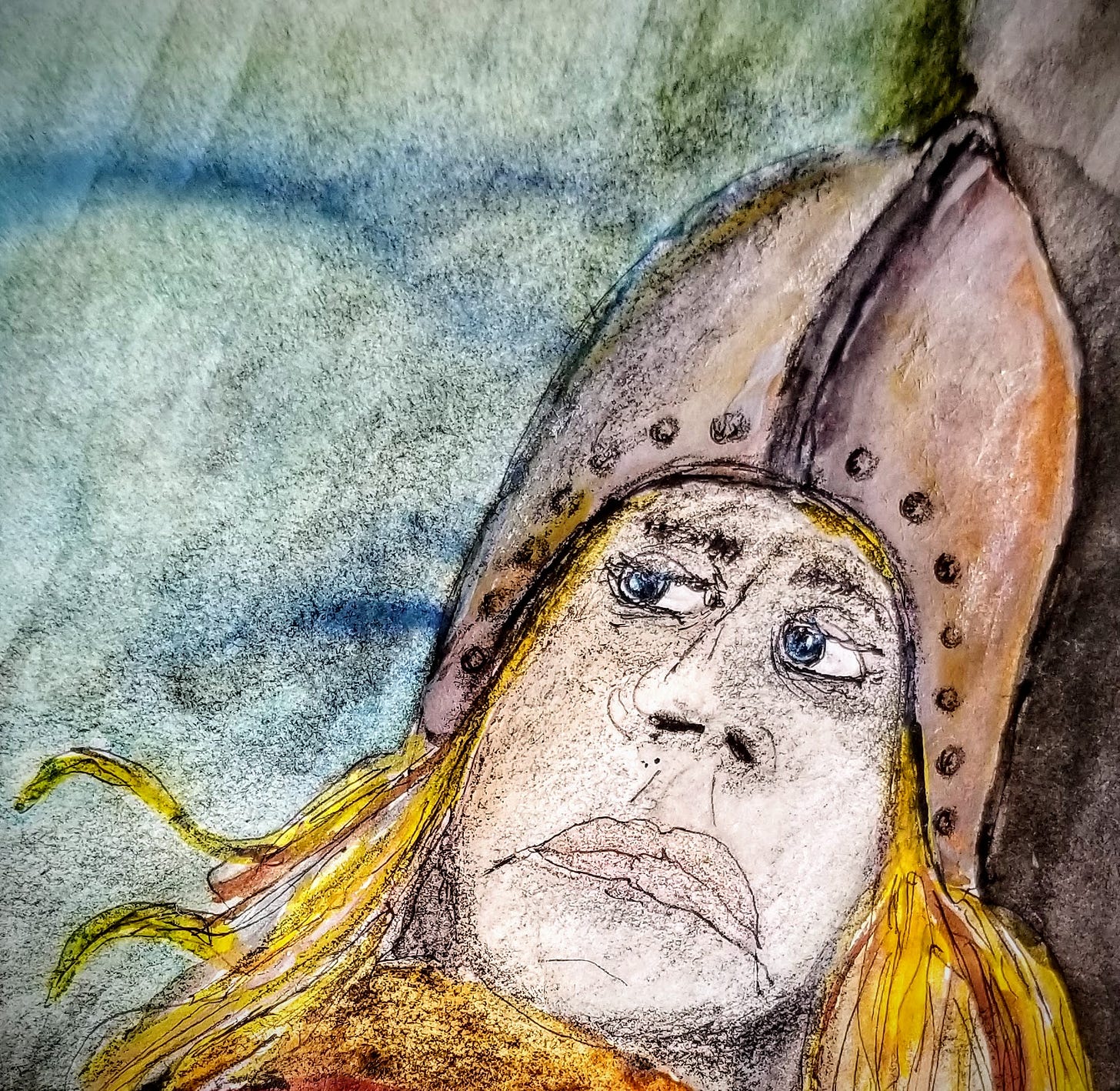
Love Klaus Kinski. Kasper Hauser (Every man for himself and God against all), Nosferatu and Burden of Dreams. But Aguirre is a masterpiece. Love your sketches and your insights.
Your color-work, Ken! Talk about a coat of many colors..